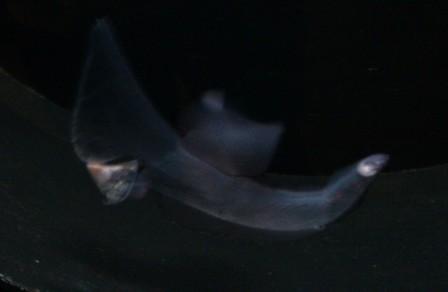
A gnarly marine snail
There is a whole class of ocean animals that I haven’t even touched upon yet, well actually there are probably a many classes of animals I haven’t touched upon yet, and one of those is the Class Gastropoda (within Phylum Mollusca), which includes sea snails and slugs. Well, this week at Cabrillo Marine Aquarium, a new snail is on display so now is as good of time as any to talk about ocean snails.
As you can tell in the photo, this marine snail does not look like the typical land dwelling snails often seen slithering along sidewalks with the characteristic spiral-shaped shell on its back. There are ocean snails that look very similar to their land dwelling cousins, with a shell and a slug shaped body underneath. But a discussion on the more ordinary looking ocean snails will have to wait for another post because the new snail at Cabrillo is a member of the Superfamily Heteropoda, a very unique bunch of snails.
The Superfamily Heteropoda includes 30 species of snails specially adapted for living in mostly warmer areas of the open ocean. Members of the Superfamily Heteropoda have greatly reduced their bulky shells, have a fin in the middle of their bodies to swim and are transparent.
The marine snail in the photo lives off the coast of central and southern California and belongs to the Family Carinariidae and is officially called Carinaria japonica. For some reason, this crazy looking critter hasn’t been given a common name, so I’ve dubbed it Carnie, this is a spin off of the scientific name, plus this animal is kooky looking enough to be in a carnival.
The photo isn’t that great because I had to take it in the dark and through the aquarium glass, but you kind of get the idea. You may have to try looking at the photo from a few different angles to see it better or click here to see a better photo. Carnie looks like a cross between a jellyfish and a flying banana, if a flying banana actually existed. The one in the photo is about 10 inches long, they tend to average closer in size to 5 inches, but can get as large as 20 inches long.
Mike Schaadt, Director of Cabrillo Marine Aquarium, explained that Carnie actually has excellent vision, it can see both forward and up, which is important for hunting prey in the ocean’s top layer where the sun still sheds enough light to illuminate potential dinner options. The fin allows Carnie to escape predators and catch planktonic prey such as salps, copepods and euphausiids. This marine snail reminds me again of how the ocean is really earth’s version of science-fiction, only it’s all real.
Flying banana is the perfect description! Thanks once again for opening our eyes to another amazing sea creature. You are spreading awareness, indeed!